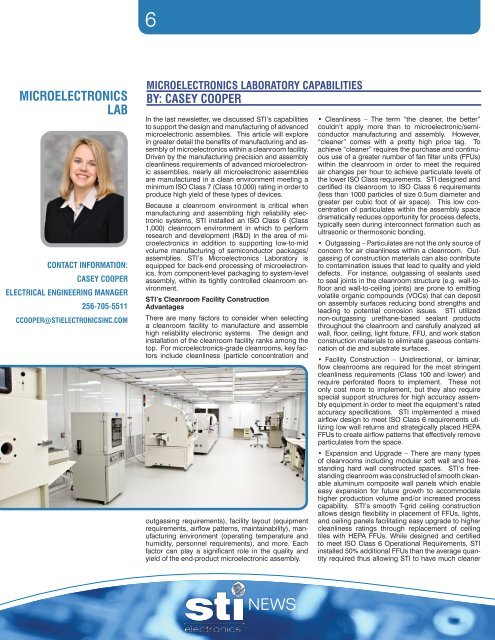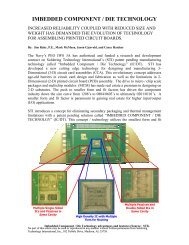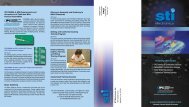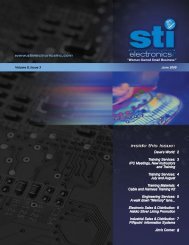Volume 11 Issue 2 - STI Electronics, Inc.
Volume 11 Issue 2 - STI Electronics, Inc.
Volume 11 Issue 2 - STI Electronics, Inc.
- No tags were found...
You also want an ePaper? Increase the reach of your titles
YUMPU automatically turns print PDFs into web optimized ePapers that Google loves.
26microelectronicslabContact Information:casey cooperelectrical Engineering manager256-705-55<strong>11</strong>ccooper@stielectronicsinc.commicroelectronics laboratory capabilitiesBY: casey cooperIn the last newsletter, we discussed <strong>STI</strong>’s capabilitiesto support the design and manufacturing of advancedmicroelectronic assemblies. This article will explorein greater detail the benefits of manufacturing and assemblyof microelectronics within a cleanroom facility.Driven by the manufacturing precision and assemblycleanliness requirements of advanced microelectronicassemblies, nearly all microelectronic assembliesare manufactured in a clean environment meeting aminimum ISO Class 7 (Class 10,000) rating in order toproduce high yield of these types of devices.Because a cleanroom environment is critical whenmanufacturing and assembling high reliability electronicsystems, <strong>STI</strong> installed an ISO Class 6 (Class1,000) cleanroom environment in which to performresearch and development (R&D) in the area of microelectronicsin addition to supporting low-to-midvolume manufacturing of semiconductor packages/assemblies. <strong>STI</strong>’s Microelectronics Laboratory isequipped for back-end processing of microelectronics,from component-level packaging to system-levelassembly, within its tightly controlled cleanroom environment.<strong>STI</strong>’s Cleanroom Facility ConstructionAdvantagesThere are many factors to consider when selectinga cleanroom facility to manufacture and assemblehigh reliability electronic systems. The design andinstallation of the cleanroom facility ranks among thetop. For microelectronics-grade cleanrooms, key factorsinclude cleanliness (particle concentration andoutgassing requirements), facility layout (equipmentrequirements, airflow patterns, maintainability), manufacturingenvironment (operating temperature andhumidity, personnel requirements), and more. Eachfactor can play a significant role in the quality andyield of the end-product microelectronic assembly.• Cleanliness – The term “the cleaner, the better”couldn’t apply more than to microelectronic/semiconductormanufacturing and assembly. However,“cleaner” comes with a pretty high price tag. Toachieve “cleaner” requires the purchase and continuoususe of a greater number of fan filter units (FFUs)within the cleanroom in order to meet the requiredair changes per hour to achieve particulate levels ofthe lower ISO Class requirements. <strong>STI</strong> designed andcertified its cleanroom to ISO Class 6 requirements(less than 1000 particles of size 0.5um diameter andgreater per cubic foot of air space). This low concentrationof particulates within the assembly spacedramatically reduces opportunity for process defects,typically seen during interconnect formation such asultrasonic or thermosonic bonding.• Outgassing – Particulates are not the only source ofconcern for air cleanliness within a cleanroom. Outgassingof construction materials can also contributeto contamination issues that lead to quality and yielddefects. For instance, outgassing of sealants usedto seal joints in the cleanroom structure (e.g. wall-tofloorand wall-to-ceiling joints) are prone to emittingvolatile organic compounds (VOCs) that can depositon assembly surfaces reducing bond strengths andleading to potential corrosion issues. <strong>STI</strong> utilizednon-outgassing urethane-based sealant productsthroughout the cleanroom and carefully analyzed allwall, floor, ceiling, light fixture, FFU, and work stationconstruction materials to eliminate gaseous contaminationof die and substrate surfaces.• Facility Construction – Unidirectional, or laminar,flow cleanrooms are required for the most stringentcleanliness requirements (Class 100 and lower) andrequire perforated floors to implement. These notonly cost more to implement, but they also requirespecial support structures for high accuracy assemblyequipment in order to meet the equipment’s ratedaccuracy specifications. <strong>STI</strong> implemented a mixedairflow design to meet ISO Class 6 requirements utilizinglow wall returns and strategically placed HEPAFFUs to create airflow patterns that effectively removeparticulates from the space.• Expansion and Upgrade – There are many typesof cleanrooms including modular soft wall and freestandinghard wall constructed spaces. <strong>STI</strong>’s freestandingcleanroom was constructed of smooth cleanablealuminum composite wall panels which enableeasy expansion for future growth to accommodatehigher production volume and/or increased processcapability. <strong>STI</strong>’s smooth T-grid ceiling constructionallows design flexibility in placement of FFUs, lights,and ceiling panels facilitating easy upgrade to highercleanliness ratings through replacement of ceilingtiles with HEPA FFUs. While designed and certifiedto meet ISO Class 6 Operational Requirements, <strong>STI</strong>installed 50% additional FFUs than the average quantityrequired thus allowing <strong>STI</strong> to have much cleanerNEWS







